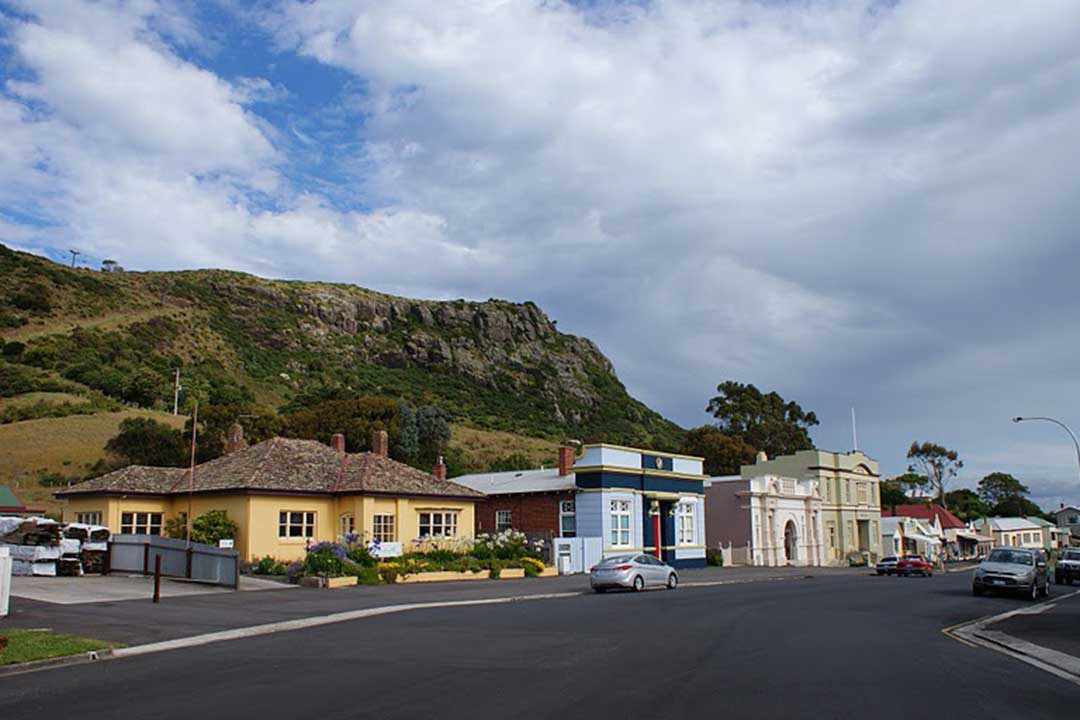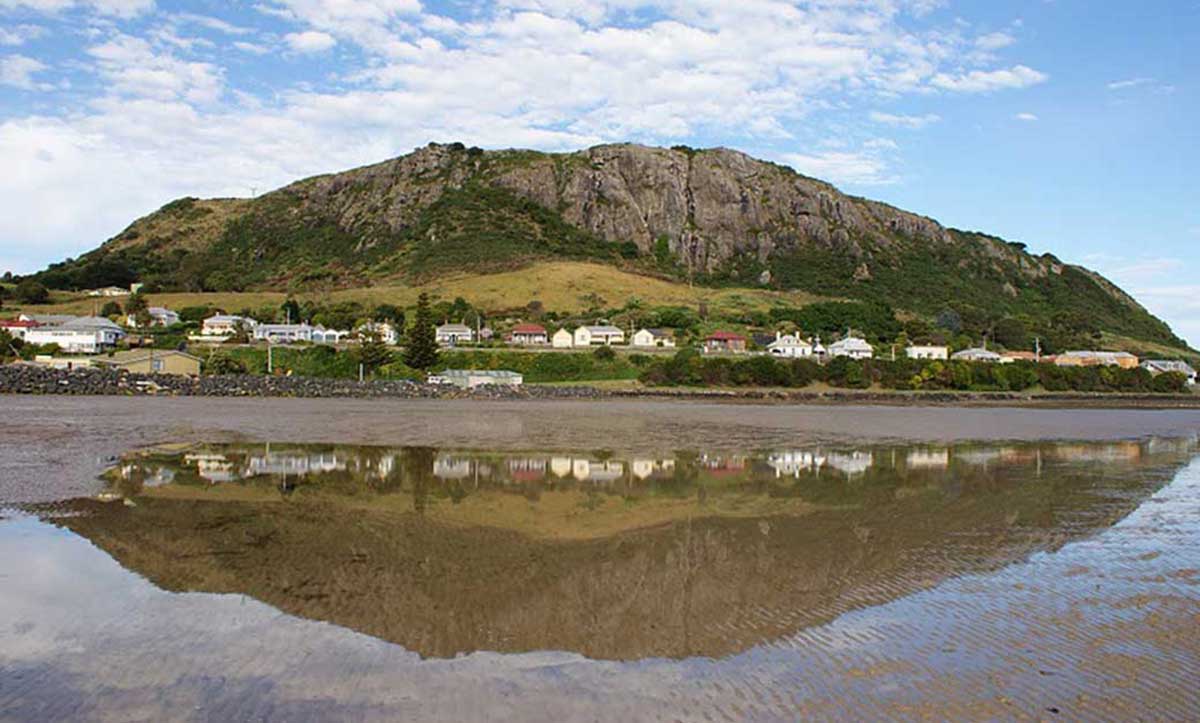
As anyone who has been there knows, the above illustration - an early depiction of the settlement at Circular Head (now Stanley) - bears little resemblance to the actual place. It was clearly not drawn by someone who had been there, and is probably based on Matthew Flinders' description of the locality: "Circular Head is a cliffy, round lump, in form much resembling a Christmas cake, and is joined to the mainland by a low, sandy isthmus. The land at the back is somewhat lower than the head, and is formed into very gentle slopes. A slight covering of withered grass gave it a smooth appearance, and some green bushes scattered over it much resembled at a distance a herd of seals basking upon a rock."
Stanley's "First Fleet"
When the Van Diemens Land Company's charter passed the great seal on 10th November, 1825, the search had begun to find the tradesmen and labourers needed to develop the large grant of agricultural land obtained in the north west of Van Diemen's Land to a financially successful wool producing enterprise. Convicts could supply free labour but they had little rural knowledge or mechanical expertise, so the indentured servant was the most reliable means of maintaining the workforce.
From 1825 the Van Diemens Land Company began to indenture men for their newly formed company. These men, some of them with their wives and families, travelled to Van Diemens Land with very few possessions. All of them left behind loved ones and their homeland knowing full well they may never return.
The rural areas of Northern England and Scotland had very little to offer the poorer class, so they were targetted for recruitment by the Company. Among them were builders, shepherds, labourers and blacksmiths, all hand picked for their skill, expertise and qualifications of good moral character and conduct.
With promises of wealth and a new beginning, the servants were eager to comply to the company's requests. Very few of these men were literate. With the contract read to them, they would put their mark 'X' as a signature. Their contracts locked them in for a set term. In return they were promised passage to the colony, food, housing, and wages. They were indentured to the Van Diemens Land Company for three years and the wages were about 40 pounds ($80) a year.
If, however, that contract was broken, then the repercussions were severe. After a disturbance in October 1827, the convicts were flogged, and the free men had their wages stopped. With the closest independent magistrate being half a world away, they had no defence. The complaints were many - inadequate food, no housing on their arrival, with conditions of low pay and low status, and being treated as equals with the convicts, their self esteem quickly diminished.
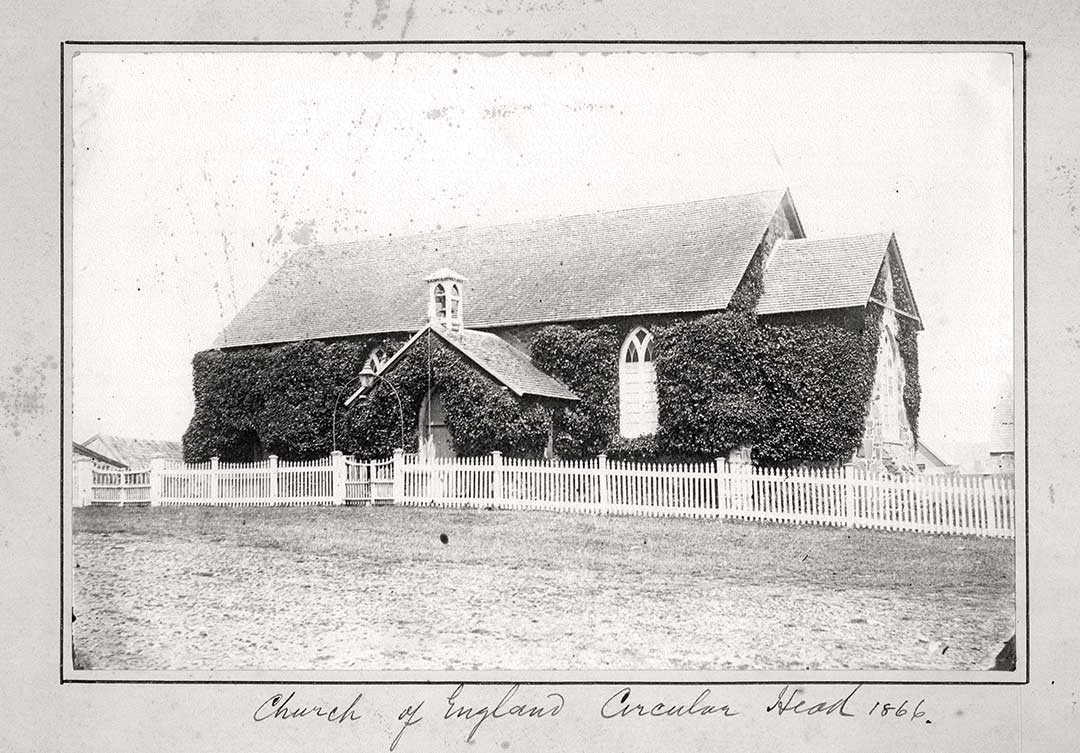
The Cape Packet
Edward Curr was selected to lead the venture, which consisted of Stephen Adey (Superintendent of the Land), Alexander Goldie (Agriculturalist), Henry Hellyer (Chief Architect and Surveyor), Joseph Fossey and Clement Lorymer (Surveyors).
These men arrived in Hobart Town on board the 250 tonne barque 'Cape Packet' on 14th March 1826, before setting sail for the North West corner of Van Diemen's Land with instructions to locate a suitable tract of land, before the arrival of the servants, stores and livestock which were on board the 'Tranmere'.
Exploratory voyages by C.B. Hardwicke (1823-4) and James Hobbs (1824) unanimously condemned the north-west coast as unfit for habitation but the Company pushed on with its plans. The men of the advance party, coming directly from England, had never experienced such wild, inhospitable country. The gloomy forests with towering trees, thick undergrowth and perpetually boggy ground made exploration very difficult. The torrential rain and sleet, biting winds, swollen rivers and dripping, rotting vegetation added to the misery and discomfort of the explorers.Nevertheless, they responded to Curr's exacting and often unrealistic demands with courage and fortitude.
Curr would eventually locate the first settlement at Circular Head, but more land was needed to complete the grant. The most fertile land was the most heavily timbered and the pioneers had neither the equipment nor the capital to undertake clearing it. The climate proved so severe that large numbers of sheep would perish at Hampshire and Surrey Hills, which were settled after Circular Head. The high rainfall at Circular Head and 'Woolnorth encouraged footrot, scab and other diseases.
The Tranmere
From the 10th July, 1825 the Van Diemen's Land Company began to purchase sheep, hire servants and chartered the brig Tranmere to carry them to the colony. When they arrived, a party of surveyors were out exploring the hinterland in an effort to locate an area suitable to establish their grant. Captain Wales had anchored the Tranmere at George Town on the 29th September, 1826, awaiting a decision on the location of settlement.
At that time, Joseph Fossey and Alexander Goldie had left the Mersey River in a whale boat, searching the coastline for a suitable location to unload the Tranmere. On seeing the sheltered port and free grazing land of Circular Head, they decided this area would make a good base for the Company's establishment.
Fourteen men, four women and three children along with nine convicts had journeyed from England. Two more men were engaged in Launceston. The ship reached Circular Head on the 24th October but bad weather hampered the brig from anchoring. The weather moderated, and, on 27th October, 1826, passengers, stores and stock were unloaded. Stanley became the first area of permanent European settlement on the North West Coast.
The Tranmere left Circular Head for North Down, a coastal locality between present-day Devonport and Port Sorell, where she loaded horses, bullocks and other sundries, taking them to the infant settlement. Here she anchored until January 15th 1827.
These first settlers were:
ALEXANDER CAMPBELL, ploughman – Berwick-Upon-Tweed, UK
WILLIAM ELLIOTT, mason, wife and 3 children – Berwick-Upon-Tweed, UK
ROBERT ELLIS, spadesman, and wife, no children – Berwick-Upon-Tweed, UK
WILLIAM LEDGERWOOD, carpenter, and wife, no children – Berwick-Upon-Tweed, UK
JOHN LINTON, shepherd - Roxburgh
NATHANIEL RUSSELL, ploughman - Yorkshire
WILLIAM RUSSELL, blacksmith - Yorkshire
JOHN SHERWOOD, ploughman - Yorkshire
WILLIAM SHERWOOD, blacksmith - Yorkshire
WILLIAM SMITH, ploughman - Yorkshire
THOMAS TURNBULL, shepherd - Roxburgh
JAMES NORTON, labourer - Roxburgh
JOHN YOUNG, millwright – Berwick-Upon-Tweed, UK
JOHN SCOTT, ploughman, and wife, no children – Berwick-Upon-Tweed, UK
Mrs Elliott was the settlement's dairywoman.
With the group from England were two sawyers recruited at Launceston and nine assigned convict servants. A further fourteen assigned convicts arrived at Circular Head in the vessel Nelson a few days later.
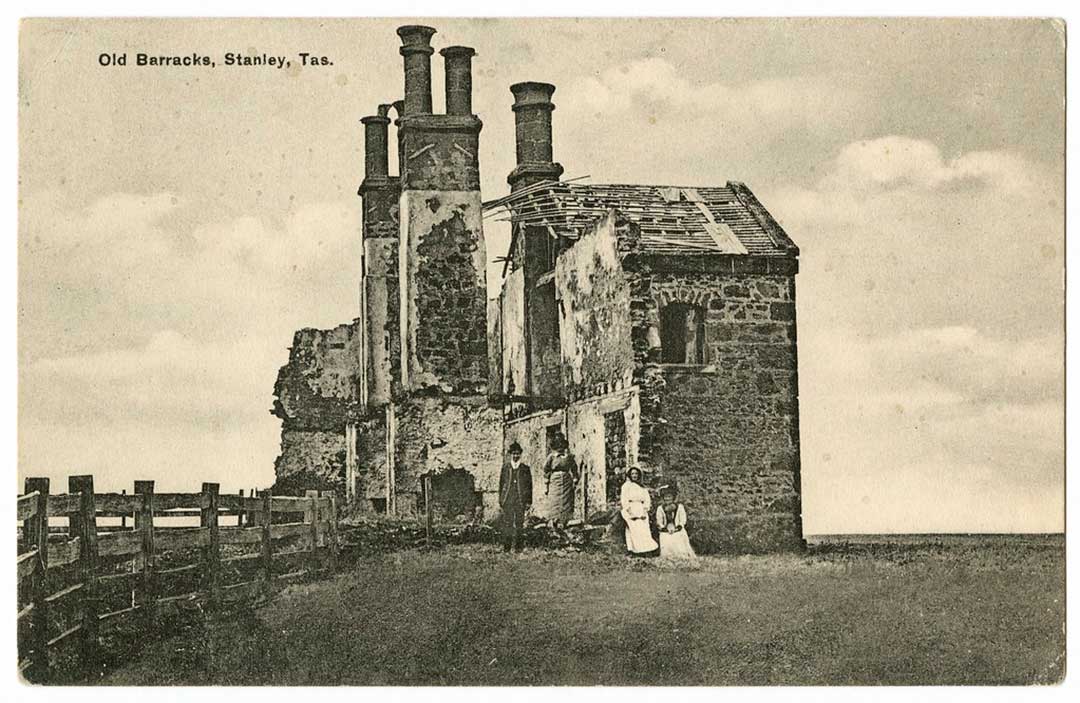
Old Barracks, Stanley
Sailing Directions For Circular Head
The Bluff from which Circular Head derives its name, is a very remarkable promontory upon the northern coast of Van Diemen's Land in latitude 40.45.13 South, in longitude 145.11.41 East, visible at a distance of eight leagues.
The Anchorage lies on the south side of it and is protected at all points of the compass except from E.S.E. to N.E. A vessel should bring up at two cables lengths from the shore with the two flag staffs in line, when she will have 6 fathoms water.
Farther within the Bay is the Company's pier affording wharf roomfor two vessels drawing 12 ft water and two or three others of lesser draught.
In medium tides, there is 14 ft water alongside in the deepest part at high water and ft at low water.
It is high water at 11.30 on the full and change of the moon.
(Signed) James Gibson Circular Head
Copy of extract from VDL Co records on film at the Hellyer Library, Burnie.
The Caroline
(Text from special supplement to The Advocate, 1981)
The Caroline was chartered by the Van Diemen's Land Company to be the first vessel to travel directly from England to the port of Circular Head.
The Brig Caroline was built in Calcutta from "fine teak" in 1825. Owned by Mr. Chapman and captained by Robert Hare, it was a relativity young vessel when leased by the Van Diemen's Land company to transport stock, cargo and servants to the newly established colony on the other side of the world.
Early in June 1827, the Caroline sailed to Hamburg, Germany, to load specially selected sheep. Returning to Hull she docked there for ten days. Five fine shorthorn heifers, a bull, eight horses, dogs, 24 male and 12 female servants with eighteen of their children boarded. On 17th July 1827, the Caroline left Hull to begin their long journey. Special containers had been built to carry the 80 tons of drinking water for the stock. This was calculated to last 150 days, deemed ample for the journey.
Although each passenger's rations of victuals was recorded, no mention was made for the amount of water allocated for the servants. The weather was not the only element hampering the journey, The brig grounded on a sand bank along the English coast, setting sail again at 5pm on the 24th July. By September 9th, the vessel was sailing the West African coast. It was here they came upon a pirate ship. Luckily, the cargo held nothing to benefit the pirates, however, they did exchanged two of the Saxony rams fortwo of their own black Spanish rams.
By the 8th November the Caroline was off the Cape of Good Hope. The water supply was proving to be not enough to get them to their destination, so they replished their water supply on arrival at Cape Town on November 11th. Fourteen days later, the final leg of their journey began. The Caroline finally arrived at Circular Head on 19th January 1828. Here, stock, provisions and some servants disembarked. The vessel then had to journey on to Launceston for a customs clearance.
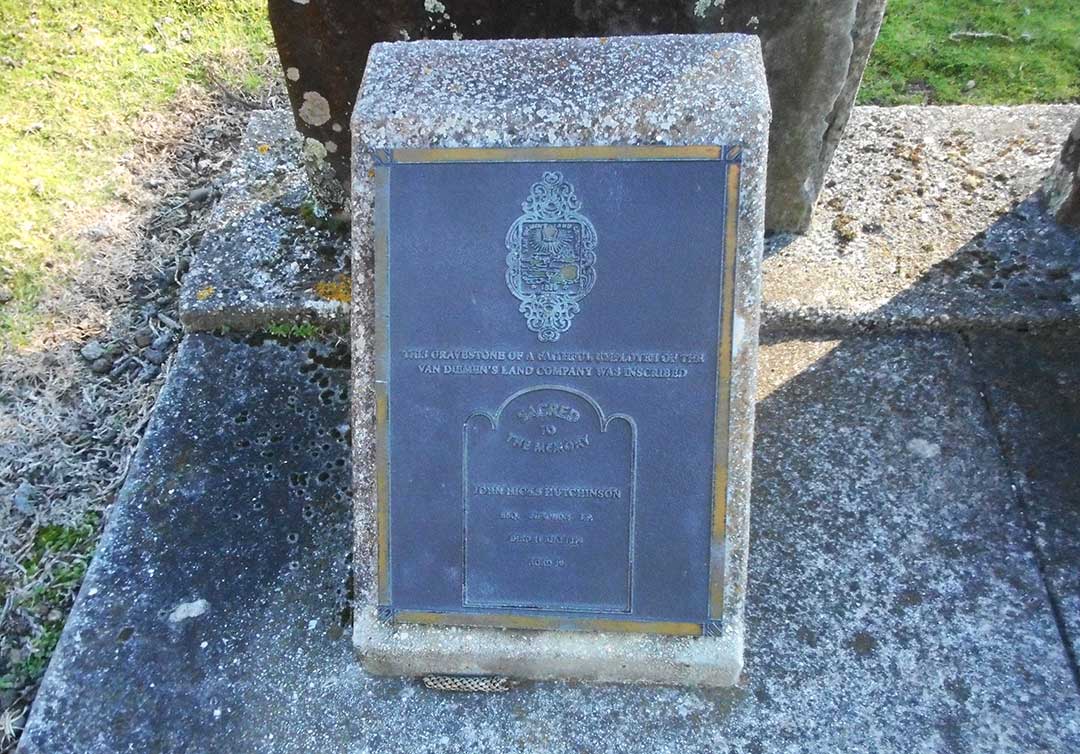
Gravestone of Dr John H. Hutchinson, Stanley Cemetery. Dr Hutchinson sailed to Circular Head on the Caroline in the capacity of the new settlement's doctor.
After the Caroline had landed some passengers and stock at Circular Head, the brig went to the Tamar (Launceston) to register its entry into Australian waters. At Red Hill, a grazing property not far down the Tamar from Mowbray, the sheep were agisted. The Caroline then returned to Circular Head.
The Caroline passenger list was:
J.H. HUTCHINSON, doctor
GEORGE ATKINSON, bailiff, his wife, Ann, and three sons, John (9), George (7) and William (2) - Stockton, UK
JOSEPH ATKINSON, farming servant, his wife, Elizabeth, and daughter, Ann (3) – Skipton, Yorkshire, UK
JOHN BAKER, sawyer and carpenter, his wife, Mary, and sons, Benjamin (9), and Samuel (2), and daughter, Elizabeth (6) - Stockton, UK
GEORGE BARRAS, blacksmith – Brompton, Yorkshire, UK
ALLAN BAXTER, joiner and house carpenter, and his wife, Elizabeth – Berwick-Upon-Tweed, UK
RICHARD CARTER, carpenter - Downholme, North Yorkshire, UK
THOMAS COWL, joiner and·house carpenter, and his wife, Jane - Norton-on-Derwent, North Yorkshire, UK
JOHN HEATON, sawyer, his wife, Ann, and daughters, Dorothy (8), Ann (6), Sarah (5), Jane (3) and Margaret (2) - Stockton, UK
JOSEPH HIND, farming servant, his wife, Barbara, and sons, James (3) and Joseph (1) – Brompton, Yorkshire, UK
DONALD McDONALD, shepherd
WILLIAM MURRAY, shepherd - Kirmshaw, UK
THOMAS NIGHTINGALE, bricklayer, his wife, Ellen, son, William (6), and daugher, Mary (9) - Thirsk, North Yorkshire, UK
JOHN PALLISER, bricklayer) - Thirsk, North Yorkshire, UK
JAMES PAWLET, farm servant - Thirsk, North Yorkshire, UK
WILLIAM PREST, farm servant – Brompton, Yorkshire, UK
JOHN RAMSDALE, bailiff, his wife, Elizabeth, son, John (2), and daughters, Margaret (15), Mary Ann (13), Elizabeth (11), Jane (9) and Ellen (5) - Stilton, Cambridgeshire, UK
WILLIAM RENWICK, shepherd - Middle Burn, UK
HENRY SLATER, cartwright and glazier, and his wife, Caroline - Bedale, North Yorkshire, England. The Slaters left the ship at Cape Town and were not found before the Caroline continued the voyage.
FRANCIS SPENCE, farm servant, and his wife, Mary - Thornton Le Moor, North Yorkshire, UK
GEORGE STEVENSON, farm servant– Brompton, Yorkshire, UK
HENRY STEVENSON, farm servant (The Stevenson name was spelt with a "v" in the VDL Co. pay-book and with a "ph" in a passenger list supplied by the Colonial Office in August 1827.) – Brompton, Yorkshire, UK
GEORGE THOMPSON, carpenter-joiner, and his wife, Elizabeth - Stockton, UK
WILLIAM WARD, farm servant, and his wife, Jane
JAMES WILSON, shepherd. – Thirsk, North Yorkshire, UK
JAMES WILSON, shepherd. – Wilhop, UK.
John Ramsdale, bailiff, and his wife and children would spend four years at Circular Head in the company employ. John's wife, Elizabeth, worked in the dairy and several of the girls worked during the latter part of their time there. Thomas Nightingale's wife also worked in the dairy. Thomas spent some time at Woolnorth during 1830, but otherwise the Nightingales were at Circular Head for the full three years.
Farming servants Joseph Atkinson, Joseph Hind and William Prest also stayed on at Circular Head. Prest stayed in the Company's employ until 1839, spending part of his time at Woolnorth. Joseph and Barbara Hind's two little boys were recorded as "workers" in 1832, the family's last year there before returning to England, even though they had reached only the tender ages of eight and six years.
Two Scottish shepherds were also based at Circular Head - William Renwick, who earned praise from his superiors and was rewarded for "outstandingly faithful work", and James Wilson. Near the end of 1829 both Renwick and Wilson were transferred to Woolnorth, where they stayed to work out their contracts.
Three other men started their time in Van Diemens Land at Circular Head but later transferred to the Hampshire Hills-Emu Bay payroll. Carpenters Allan Baxter and Thomas Cowl would have been put to work immediately at Stanley to provide additional homes and other buildings. By April 1828 Baxter and his wife, Elizabeth, had moved to Hampshire Hills. Cowl and his wife, Jane, stayed for another year at Circular Head and in December 1828, their son, Robert Cowl, was born.
Doubtless other babies were born to worker couples in the three years they were employed by the Company, but as yet the records have not been found. Thomas and Jane Cowl, with baby Robert, moved to Hampshire-Emu Bay in April 1829. Farm servant Henry Stevenson also made a move in April 1829.
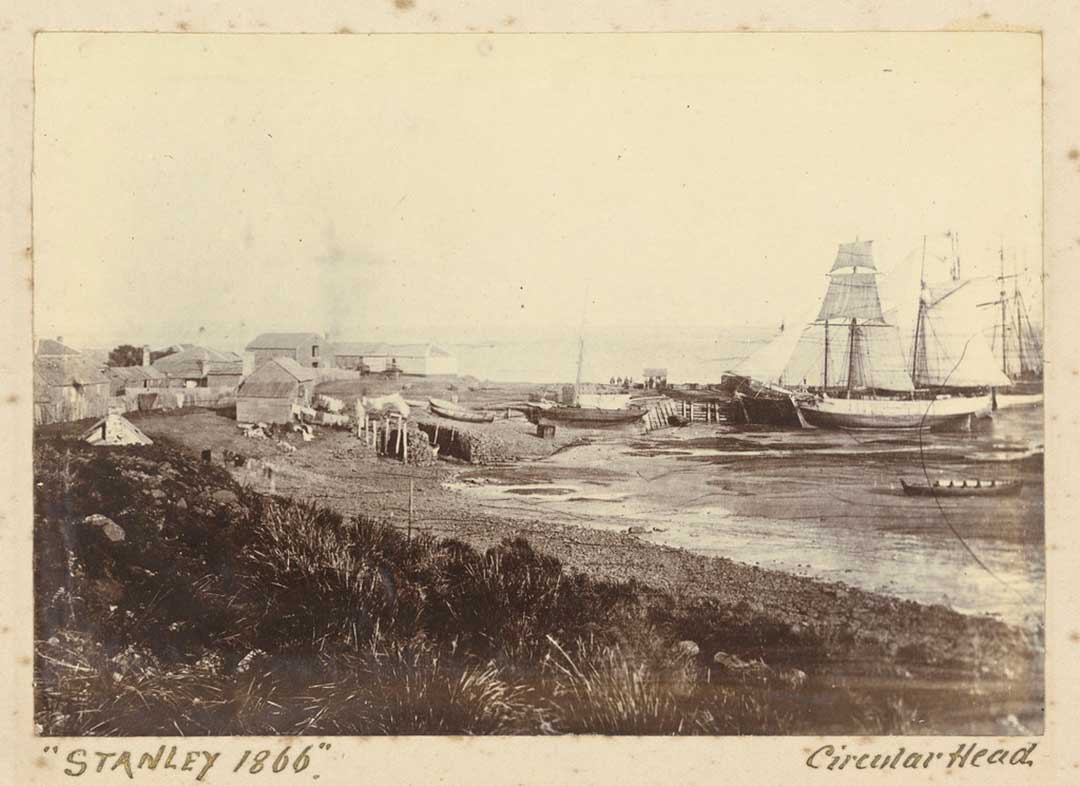
Stanley wharf, 1886
Distribution of the workforce
When the Caroline moved to the Tamar to agist the valuable Saxony sheep, three workers remained at Red Hill or at a staging base near Quamby (Westbury) to tend stock. They were George Atkinson, bailiff, his wife, Ann, and three of their children (they had left another son in England); shepherd Donald McDonald, who also earned commendation for faithful work; and George Stevenson, farm servant. In 1830 all of them joined the Hampshire Hills settlers.
Those destined for Emu Bay stayed on the Caroline while the brig went to the Tamar and back to Circular Head. Then they set out in the cutter Fanny for Emu Bay, arriving 22 February 1828. They were: blacksmith George Barras, bricklayer John Palliser, sawyer John Heaton, sawyer-carpenter John Baker, carpenters Richard Carter and George Thompson, shepherd William Murray and farming servants James Pawlet, William Ward and Francis Spence. The wives and children of Heaton, Baker, Thompson, Ward and Spence went on to Hampshire.
Records show that all these workers stayed around the Emu Bay, Hampshire and Surrey Hills districts for their three years' service; joined, of course, by other carpenters and farming servants as mentioned above.
They had trips to Circular Head, and seem to have been moved between Emu Bay and the inland estates as their services were required. George Barras went back to Circular Head almost immediately for some work in March 1828; John Palliser was there in February 1829 and Richard Carter was transferred permanently to Circular Head from July 1830.
After Thomas Cowl's transfer to the Emu Bay payroll (which included Hampshire and Surrey Hills) in April 1829, he was at Emu Bay for four spells of work till the end of 1829, then at Burleigh (near Guildford) for some months, and the remainder of his term at Hampshire.
As at Circular Head, some wives and children worked. Mrs Heaton "attended" Emu Bay-Hampshire superintendent Alexander Goldie, presumably housekeeping for him at Hampshire. Mrs Ward worked occasionally doing washing, and by the end of 1828 the Baker lad, Benjamin, then aged about 10, had started work.
This group took part in the very beginning of the Hampshire settlement and helped its transformation, as described by Governor Arthur on his journey in January 1829, from living in hollow trees to an "admirable settlement".
Of the 14 men from the Caroline in the Hills region, only a few continued after their indentures expired on 19 January 1831. Allan Baxter and family stayed till the end of 1839, William Murray until March 1837, Henry Stevenson until mid-1835, and William Ward until May 1831. George Atkinson and family stayed for some years after the end of their three year term.
Eventually the Caroline people moved on to occupations at places of their own choosing. Many had saved money for a new start in their adopted land. In pioneering assisted migration of free settlers, the VDL Company gave them their opportunity; they had the courage and the endurance to take it; and Van Diemens Land, and later Australia, was richer for their presence.
The Atkinsons: Pioneers at Emu Bay
Joseph Atkinson was given charge of the horses on board the Caroline. He ultimately became a Burnie farmer, and his descendants to the sixth generation still live in the district.
"Old Joe" Atkinson, as he later became popularly known to Burnie people, was indentured as a farming servant from the village of Skipton upon Swale, in North Yorkshire, at an annual wage of $60. His experience with pit ponies in the Yorkshire coal mines gave him the extra job as groom during the Caroline's voyage. He had eight horses to look after.
The other stock on board consisted of five cows, one bull, seven dogs and 305 Saxony sheep. Two of the horses were stallions. One died early on the voyage, and the second was so badly gored by the bull when the pair were being landed at Stanley in a longboat that it had to be destroyed.
Little is known of Joseph Atkinson's early association with the VDL. Company, except that he continued to look after horses at Circular Head, and engaged in general farm work. Most Caroline passengers saw out their indentures, but records show that people from later charter ships stayed only briefly before finding an escape clause in their agreements.
Joseph Atkinson appeared as a property holder in a review of Emu Bay settlers published in 1850. His farm was near present-day Aileen Crescent, and among other pursuits he raised pigs - naturally enough, the Yorkshire breed.
The Atkinsons had a son, William, and another daughter, Elizabeth, who married Burnie's first hotel-keeper, Joseph Law, and lived at the Burnie Inn. The Laws had a daughter, and appropriately named her Caroline. Law later established a brewery and hotel, the Stratham, at West Burnie.
From the son, William, there are many descendants still in Tasmania, as well as in Victoria, N.S.W. and New Zealand. William married Catherine Saunders, of Campbell Town, and had a big family. He first farmed alongside his father, approximately where the Montello Primary School is now. Later he had a farm south of Roslyn Avenue, where Parklands High School has been built.
Their eldest daughter, Catherine, the first child registered on the first Emu Bay births register, later became Mrs David Storrer. Mr Storrer was Mayor of Launceston in 1903. Catherine was born on 21 November 1856 (Until the Emu Bay register was commenced, all babies were registered at either Stanley or Port Sorell).
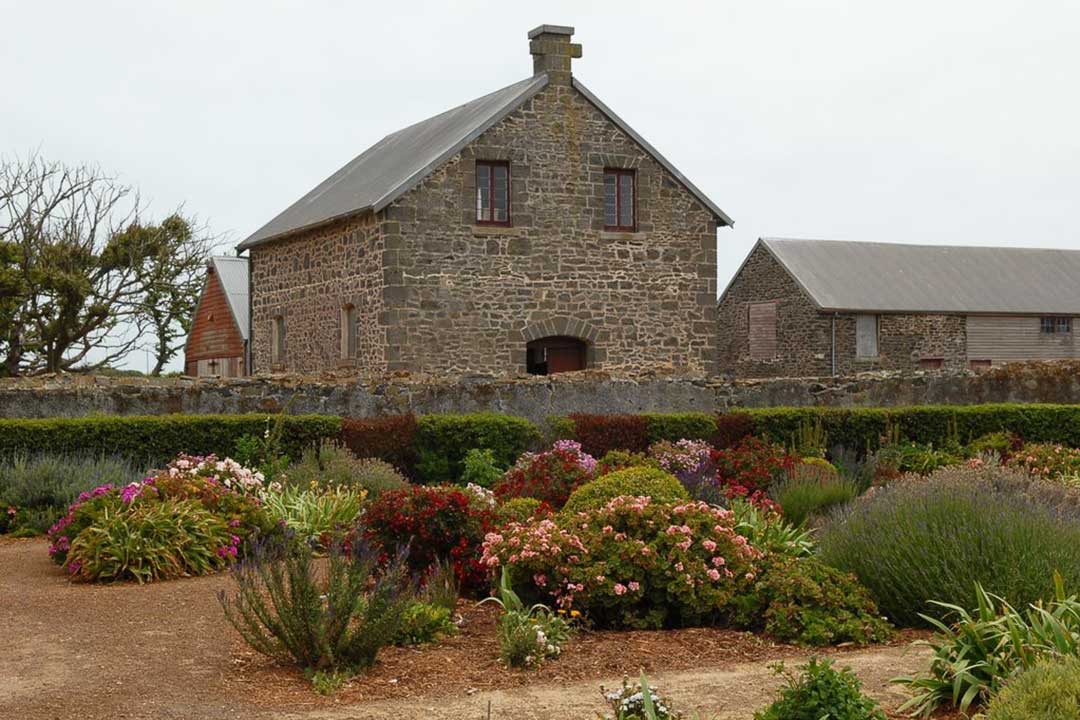
Highfield Outbuildings
The Fate of the Advance Party
Of the six men of the Advance Party who had set out so enthusiastically in 1826 only Curr was left in 1832. The others were overcome by the problems, pressure and loneliness they encountered.
Clement Lorymer was sensitive, timid and indecisive, but worked diligently in the exploration of the Circular Head area - he drowned while crossing the Duck River.
Stephen Adey was intelligent, but incompetent and easily defeated - he resigned as superintendent after only one year and became the agent in Hobart Town. He, together with several other wealthy Hobart Town residents, established the Derwent Bank - a rival to the VDL Bank - and was the managing director, as well as being the VDL Company's Agent. He and his wife did not endear themselves to the citizens of Hobart Town. He transferred the VDL Company account to his own Derwent Bank. Adey refused Curr's instructions to return the account to the original bank and was strongly censured by the Court of Directors. After returning the account to the original bank, Adey resigned.
Joseph Fossey was reliable and achieved a great deal, but he found the problems and isolation too much. As soon as his contract expired, he applied for a land grant in the north. Fossey worked for a short time as temporary assistant government surveyor. He married in Launceston in 1835 and spent a few years on his farm before moving to Victoria in 1844.
Alexander Goldie was confident, intelligent and callous, ill treating the company's horses and bullocks. He was also inVDLved in the murder of an Aboriginal worman near Emu Bay (Burnie) in 1829. He resigned as soon as his contract expired and became manager of Sir John Owen's estate '0rielton' on the east coast.
Hellyer was loyal, hard-working and courageous. His name is synonymous with exploration on the north-west coast. Between 1B26-8 he penetrated almost every corner of this rugged quarter of the island. Unfortunately he became ill and unstable and shot himself in 1832. His memorial is in the old Stanley Cemetery.
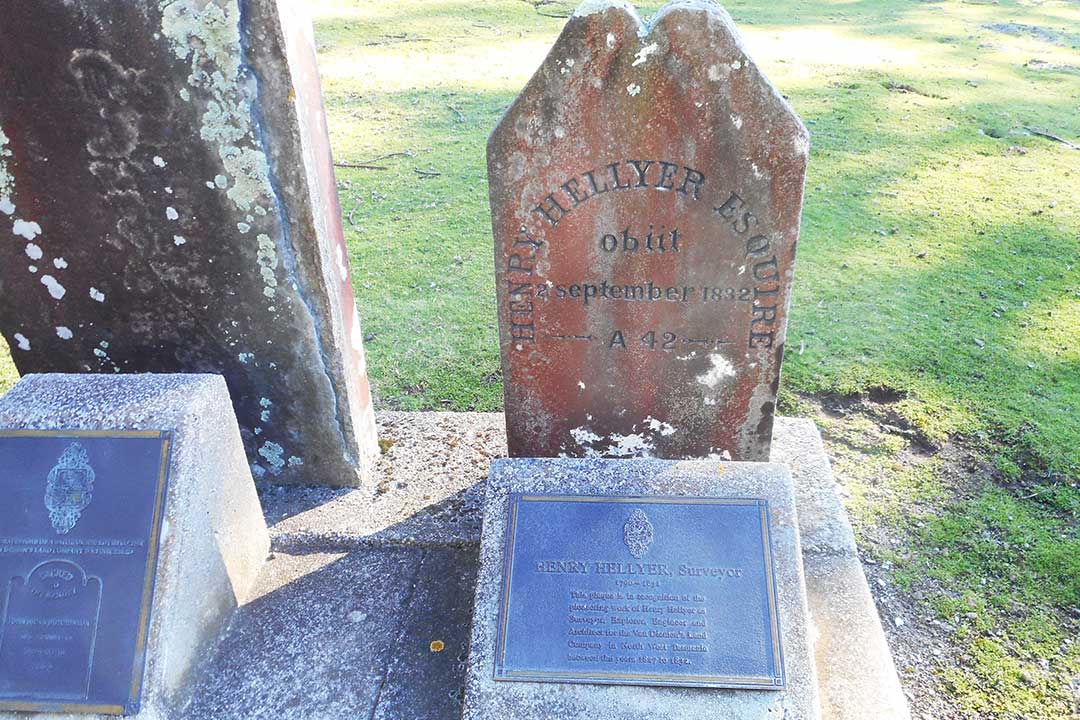
Gravestone of Henry Hellyer, Stanley Cemetery
Edward Curr was determined, imperious and controversial. He was belligerent, demanding and overbearing at times, yet quite sensitive. This last trait was to eventually lead to his being asked to leave the VDL Company in 1840. He and his wife and family lived at 'Highfield', built between 1832-5. He, together with his very large family (eventually 9 boys and 3 girls) moved to Victoria after he left the Company's employ.
Much was contributed to the whole north-west coast by these six pioneers and their staff, but little was received in return. They explored so much territory and opened up so much land, and were also instrumental in starting the towns of Stanley, Smithton and Burnie.
The VDL Company itself survived beyond 1832 but only after a change in policy. It is the sole survivor of the myriad of companies formed in the boom years 1824-6. Today its unique heritage makes the establishment at 'Woolnorth' a major tourist attraction as well as a thriving pastoral enterprise.

